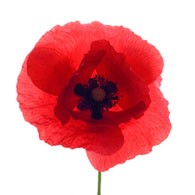|
|
||
|
|
The Poppy Zone G6 Poppy Chair Barry Pascoe zoneg6poppychair@gmail.com The Legion's Poppy Campaign begins on the last Friday of October and runs until November 11th
The poppy, an international symbol for those who died in war, also had international origins. A writer first made the connection between the poppy and battlefield deaths during the Napoleonic wars of the early 19th century, remarking that fields that were barren before battle exploded with the blood-red flowers after the fighting ended. Prior to the First World War few poppies grew in Flanders. During the tremendous bombardments of that war the chalk soils became rich in lime from rubble, allowing 'popaver rhoeas' to thrive. When the war ended the lime was quickly absorbed, and the poppy began to disappear again. Lieut-Col. John McCrae, the Canadian doctor who wrote the poem IN FLANDERS FIELDS, made the same connection 100 years later, during the First World War, and the scarlet poppy quickly became the symbol for soldiers who died in battle. Today, fields of brilliant poppies still grow in France. Three years later an American, Moina Michael, was working in a New York City YMCA canteen when she started wearing a poppy in memory of the millions who died on the battlefield. During a 1920 visit to the United States a French woman, Madame Guerin, learned of the custom. On her return to France she decided to use handmade poppies to raise money for the destitute children in war-torn areas of the country. In November 1921, the first poppies were distributed in Canada.
Thanks to the millions of Canadians who wear
poppies each November, use of the little red flower has never died.
And neither have Canadian's memories for 116,031 of their countrymen
who died in battle. Many Canadians believe that the most important role of the Legion is to maintain the tradition of Remembrance day. The Legion’s Remembrance Day programs allow us to honour all the men and women who served and died in military service in the two World Wars, the Korean war as well as the peacekeeping missions. Every year, there are thousands of dollars and voluntary hours committed to carry out the Remembrance Day programs and activities. The Poppy and Remembrance Day Campaign takes place every November just prior to Remembrance Day. The campaign aim is to raise awareness of the poppy as a symbol of Remembrance Day.
Proceeds from this campaign support veterans,
ex-service members and their families who are in need. Since
adopted, the poppy has become one of the most widely recognized
symbols in Canada. Every second summer, the Legion organizes a pilgrimage for youth leaders to Canadians memorials in Europe. The Legion also supports the Canadian War Museum and other military museums in Canada. The challenge facing the Legion today is to convince young people and future generations of the need to remember those who have died in the wars to give us peace. The majority of Canadians don’t recognize the horror of the wars because they have never been exposed to it apart from what is seen on the media.
|
|
|
|
||

 Why
was the poppy chosen as the symbol of remembrance for Canada's war
dead?
Why
was the poppy chosen as the symbol of remembrance for Canada's war
dead?